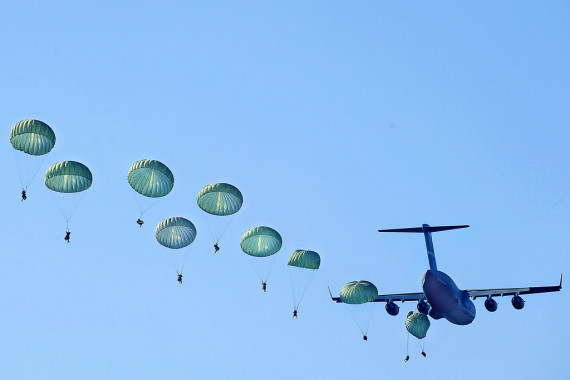Business Myths About Military Leaders – Myth #2
“Anderson! You have to be like Gumby! Come up with a new plan and do it quick or your men will die!” These words echoed through the woods as I stood confused during my first attempt leading an infantry squad during Cadet Basic Training at West Point.
The staff sergeant wasn’t going to allow me to implement my plan when the circumstances had changed. It was a lesson I would be taught often as a cadet and as a young officer.
Attention Business Leaders: You have to be flexible to lead in the military.
Too bad business leaders don’t realize military veterans go through this type of training. The myth that military veterans are inflexible would be dispelled and more businesses would see veterans’ military experience as an asset instead of a weakness.
When I asked for business myths about military leaders from veterans who are now engaged in business, one of the most prevalent myths centered upon the idea that military experience makes people too inflexible in business.
Three Lessons In Military Leadership Flexibility
1. The Flexibility of Plans
It’s not the plan that’s important. It is the planning. In battle the plan often goes out the window when the first shot is fired. Circumstances change rapidly on the battlefield. The enemy, the weather, the communications, the fuel supplies etc. rarely cooperate and do what you want them to do.
That is why the planning is more important than the plan. In a good planning process, different scenarios are evaluated and discussed before a final plan (Plan A) is settled upon.
Thinking through the other possibilities ahead of implementing Plan A gives a leader a stable of alternatives after the first plan goes to hell in a hand basket.
This allows the leader to change course quickly when Plan A doesn’t work. The leader has Plans B, C, and D on tap based on the new circumstances.
Military leaders are trained prepare alternate plans should Plan A not work. They are not thrown off by changing circumstances. They just adapt.
Doesn’t that sound like what any business would want at all levels in its organization?
2. The Flexibility of Styles
In the military we learned quickly to adapt our leadership style to the people we were communicating with. As a 23 year old lieutenant, I communicated with corporals who were my age and a platoon sergeant who was 50 years old. The same leadership style was not going to work.
I was an age group peer to my corporals but a snot nosed kid to my platoon sergeant. But in both cases, I was their superior in rank. Navigating this dynamic often determined whether a young officer would succeed or fail in his/her first leadership assignment.
At the same time, having a flexible leadership style was critical as circumstances changed. Leadership when people are shooting at you is different than leadership in motor pool back in the United States.
Ken Blanchard’s theory of Situational Leadership was an essential tool for all military leaders. We weren’t taught the theory itself, but we were trained in the principles. Why?
Because being flexible in leadership styles is what good leaders do. Being flexible is how good leaders get things done and have the most impact on those they lead.
Doesn’t that sound like what any business would want at all levels in its organization?
3. The Flexibility of Ethics
History proves that flexible ethics in battle gets people killed. The military leaders who display situational ethics will have limited success. They will not be the ones who have the trust of their men. They will not be the ones who receive the high ratings from their superiors.
At West Point the Cadet Honor Code states: “A cadet will not lie, cheat or steal nor tolerate those who do.” This code is prevalent throughout all the military services and appropriate conduct is expected. You trust your brothers and sisters in arms because you know they believe in the same code of conduct.
As leaders in the military and in business, we should all strive to do live and lead by the following code:
“Be flexible with your methods but never with your ethics.”
Doesn’t that sound like what any business would want at all levels in its organization?
The Bottom Line:
Business leaders are right and wrong. They are right in to desire leaders who are flexible in the face of the changing business environment. They are wrong when they assume our veterans are trained to be inflexible.
Inflexibility in military leadership kills. Whether it was at the Battle of Antietam in the Civil War or at My Lai in Vietnam, inflexible leadership resulted in intolerable loss of life. In business, the failures are not as devastating, but they are still intolerable.
That lesson has been learned in the military and is reinforced through training and through the overwhelming success our military achieves in no matter where they are serving.
Flexibility in the face of constant change, diverse people and circumstance will make a former service member an important part of any business team. But it is their inflexibility in their ethics which will make them invaluable.
Question:
What situations in business have you encountered where these lessons in flexibility were in play?


Hi Dave, great post.
As Dwight D. Eisenhower once said: “Plans are nothing; planning is everything.”
It is the planning process that allows one to identify potential pitfalls and establish contingencies. Things rarely go as planned; understanding this and being prepared are the keys to success.
Another thing that should be kept in mind is the hierarchy of mission and objectives. The higher up the hierarchy the less flexibility there should be, while lower in the hierarchy more latitude should be allowed. However, even at times lower level processes must be strictly adhered to such in cases of product safety.
Flexibility in leadership style is much more difficult to pin down. Our basic personalities determine our leadership style (I’m an Analytical-Driver type). Understanding your style and how that comes across is critical to being effective. I know that I can come across as being cold and uncaring. Therefore, I make it a point to ensure that the people that I am working with know that I appreciate their efforts. Going back to your previous post that mentioned the movie Patton; the contrast between the leadership styles of Generals Patton and Bradley are an excellent example. Their leadership styles are pretty much polar opposites, yet both effective.
As for ethics, NEVER BEND! I have seen the results of shipping defective products or the fudging of numbers to make the quarterly report look good. Also, your subordinates will follow your example. If they see you compromising standards they will think that it is ok for them to do so as well. While it may make you look good in the short term the long-term effects are disastrous, to both you and the company.
Chris- I always loved that Eisenhower quote. Thanks for the great insights!
While I agree in principal, having worked for a Marine Corps Col and his O5 partner, they were the worst employers possible.
Their flexibility was non-existent, they were far too rigid with no clue as to how to be flexible, and their methods of “encouragement” were no more than those of the stereotypical drill instructor.
I grew up in a military household, of a career Air Force man. Things were rigid around the house but flexibility was present within the rigidity. Thanks to some of that rigidity growing up there are a few things that I am only now forcing myself to learn because I was not allowed to try as a youngster. I also learned quite well the value of order in the household as far as organizational skills go and precisely what was meant by punctual.
Do many of the attributes learned in the military have the possibility to translate well into the private sector? Certainly! It all depends on the individuals and how they digest their military training and transition it to the private sector and relate to employees outside of a military “do it my way because I am the ranking officer” setting.
It is the stereotype I want to dispel. I’ve had leaders just like the Marines you had who went to Ivy League schools and the only uniforms they wore were prep school uniforms.
It is critical to look at the individual and not at the prior service when critiquing flexibility in leadership.